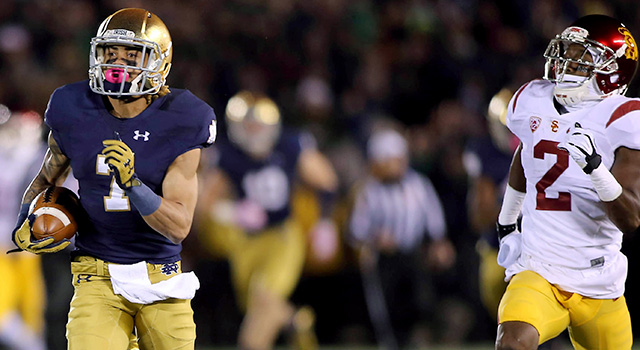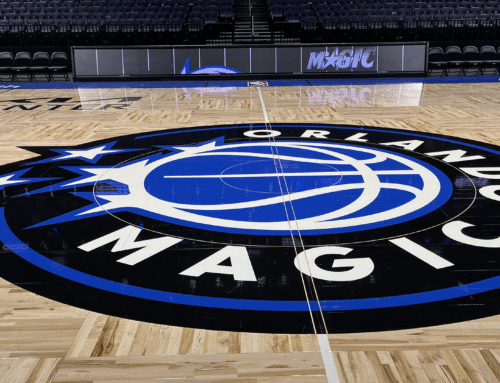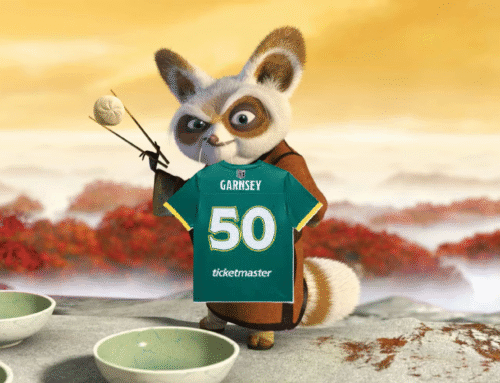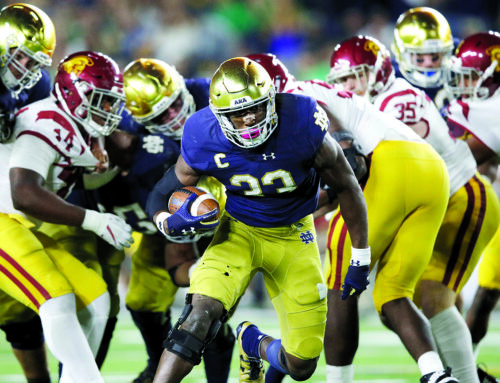Ahead of Saturday’s battle for the Jeweled Shillelagh (anyone notice Brian Kelly is super into rivalry trophies lately?), how do the Trojans and Irish match up in each advanced stats category? Where is USC susceptible, and what should Notre Dame fans be worried about?
USC Offense vs. Notre Dame Defense

Immediately after the loss to Georgia, there was a two-part reaction: “The Notre Dame defense might actually be good!” immediately paired with “We might not really know until USC though”. Since that game the Irish defense hasn’t dispelled the notion that they might in fact, be good. Mike Elko’s unit has thrived on a combination of limiting opponent efficiency and clamping down in scoring territory. Forcing turnovers has also been an integral part of the defense’s success, and on Saturday the Irish will face a USC offense that’s given the ball away 2.29 times per game (117th in FBS).
The Trojan offense is likely the best Notre Dame will see this season – USC is equally able to run and pass, and has been very efficient and occasionally explosive. It’s a testament to Sam Darnold and company that I think the consensus would be that the #18 offense per S&P+ has actually underachieved this season. USC has been mediocre in 2017 in terms of finishing drives – 55th in points per trip inside the opponent 40 and 59th in points per red zone visit (4.97). In a game where scoring opportunities for each team will likely be close, finishing drives might be the difference in this game.
USC Rushing Offense

Ronald Jones is an easy selection for “Scariest opposing running back, non-UGA division”. The junior tailback is averaging 6.3 yards per carry, and ties for 20th nationally with 20 carries of 10+ yards despite a modest workload. Still, the USC running game has been inconsistent in 2017, mostly owing to a mediocre offensive line. Against the better defenses on their schedule, the Trojans posted modest to poor rushing success rates – 41% against Utah, 30% at Washington State, and 29% versus Texas.
One solution to more consistency could be simply more opportunities – Jones and freshman Stephen Carr (status unclear for this weekend with a foot injury) are both going for around six yards per rush. Yet USC is 97th in FBS in standard down run rate and 107th in passing downs run rate, choosing to lean heavily on Sam Darnold instead. It also could reflect a lack of confidence in the Trojan O-Line, which has battled injuries and ranks just 55th in adjusted line yards (an opponent-adjusted measure that separates credit for runs between running backs and the line).
On the opposite side of the ball, the Irish run defense has been extremely sturdy if not flashy. On one hand, holding the UGA running game 32% rushing success rate bodes extremely well for the second night game of the year. From a glass half-empty perspective, has Notre Dame faced an offense this season that has a remotely dangerous passing attack? Will the run defense still hold up as well with a skilled quarterback posing a threat? The bye week could also benefit the Irish defensive line, which has had an especially thin rotation on the interior and will expect a lot from Jerry Tillery and Jonathan Bonner is this game.
USC Passing Offense

Darnold holds the keys to the USC offense, and the passing attack has been efficient but not explosive. The Trojan offensive line has held up decently in pass protection, and Darnold has excelled on passing downs, where USC is 10th in S&P+. Against Utah the NFL prospect was constantly improvising and scrambling to convert third downs – for better (USC is 5th in 3rd Down S&P+) and worse (risky passes and fumbles have led to 9 interceptions and seven lost fumbles).
The combination of turnovers and a lack of big plays add up to the 43rd best passer rating in FBS, ironically next to USC transfer Max Browne (now at Pitt) and inconsistent youngsters like Miami’s Malik Rosier and Mizzou’s Drew Lock. Darnold and the Trojans certainly have the potential to be as dangerous as any offense through the air, but the lack of downfield threats (no wide receiver averaging more than 9 yards per target) and protection are limiting that potential.
The only holes in the Irish pass defense have come when competing for jump balls, mostly in the red zone. The Trojan offense isn’t full of big, physical receivers – top target Deontay Burnett is 6’0 and 170 pounds – but they may test the Irish corners to the sidelines and target their big tight ends over the middle. Darnold seems to be missing a top-flight receiver with the departure of JuJu Smith-Schuster, although the tight end corps (junior Tyler Petite and sophomore Daniel Imatorbhebhe have been strong downfield options with limited targets) may stepping up a little in his absence. This is a strength on strength matchup with USC’s hyper-efficient passing offense facing a stingy Notre Dame pass defense.
Notre Dame Offense vs. USC Defense

Can the Irish offense be efficient enough to eventually break some big plays on the USC defense? The Trojans have been strong at holding down opponent efficiency, which is more sustainable in the long run than limited opponent explosiveness (where they’ve struggled). I’d expect this to even out over time, but it may not be this weekend on the road against a very explosive ND offense. Strength also meets strength in the scoring opportunities arena, where both the Irish offense and SC defense have been very good at scoring and containing opponents, respectively.
Notre Dame Rushing Offense

USC’s run defense has been operational, but not particularly good limiting opponent explosiveness or efficiency. Stanford rushed for 7.6 yards per carry against the Trojans, Utah went for 5.0, and Wazzu 6.6. USC completely bottled up Texas, but offenses that are good at running have run the ball on them. And Notre Dame has been very good at running the ball.
USC’s defensive line has been strong in havoc rate (30th nationally) but their poor stuff rate shows that performance has almost entirely come against the pass. The Trojans have stiffened up in power run situations, but on most occasions aren’t stopping opponents at or behind the line of scrimmage. Their defensive line rankings against the run are making Harry Hiestand drool – 99th in stuff rate, 67th in adjusted line yards allowed, and 78th in opponent opportunity rate (percent of runs giving up five yards or more).
Light up the #1 on Grace Hall! S&P+ likes the Irish running attack as the best in the nation, which I won’t argue with. Interestingly enough Notre Dame has gotten it done with the same formula that led them to the top spot in this category in 2015 – good (but not great) efficiency and excellent explosiveness. The future also looks strong for the efficiency numbers, as the Irish are much better so far in power run situations and avoiding run stuffs than they were in 2015.
Notre Dame Passing Offense

USC’s pass defense is probably the single best unit so far on this Trojan team. Even in the loss in Pullman, it took Luke Falk 51 attempts to get his 340 yards (a poor 5.8 YPA), and Clancy Pendergast’s defense picked him off once and sacked him five times. The secondary is talented and aggressive, and gets their hands on a lot of passes (8th in pass deflection to incompletion ratio). If the Trojans have a weakness, it’s allowing the occasional big pass – they’ve given up five of 40+ yards – but their IsoPPP is a little inflated as a result of their strong efficiency numbers. (Sidenote: Guess who is tied for first in the nation with zero 40+ yard passes allowed? Take a bow, Mike Elko).
With a strong pass defense and pass rush coming after Brandon Wimbush, the Irish are going to work hard to again avoid a lot of long passing downs. I was shocked to see the Irish ranked 5th in Passing Downs S&P+, but digging deeper this is really the result of some strong tendency breaking (running the ball on passing downs) and Wimbush scrambles. Notre Dame has a ton of long runs broken on 2nd and 10 rushes, and the backbreaking Wimbush runs at BC add up here. Expect a heavy dose of the run game on 1st and 2nd down with shots sprinkled in deep to Equanimeous St. Brown and newly out of the doghouse Kevin Stepherson.
Predictions
S&P+: Notre Dame 32, USC 26
Sagarin: Notre Dame 37, USC 27
The advanced stats all like the Irish at home – FEI, the Power Rank, and Massey-Peabody also all have Notre Dame ranked above USC. I expect a closer game – in Elko I trust, but there’s some danger here in the matchup against a strong passing attack and pass defense. If the Irish get an early lead I think Darnold can lead USC back into the game; if the opposite takes place, I hope Chip Long and Brian Kelly have the discipline to stick with the run. The Irish need to win the turnover battle, but Darnold has been extremely turnover-prone, which bodes well for the home team.At the end of the day I give ND a slight edge – I think the Irish running attack is the single best unit in this game, and Mike Elko can company also have a small edge in the trenches.
After USC
Thanks to all who submitted questions in the comments of last week’s advanced stats review – most of them concerned the 2nd half schedule. Brendan did a fantastic job previewing the final six games here yesterday, so I’ll just highlight one question that’s interesting to look at:
“Who do we have left that we match up well against statistically, or don’t. Our remaining opponents are generally strong – but can we look at the matchups more in light of strengths vs. weaknesses? Eg. If an opponent is weak against the run (a weakness we could easily exploit) it likely wouldn’t be as hard of a matchup for us as a team that is strong in that regard” – Scarponi
I think the example mentioned here by Scarponi is probably the biggest factor in determining matchup success or failure – how well do opponents fare against the run? Georgia provided the blueprint for slowing down the ND offense, except the number of teams with the talent to shut down the Irish running attack and not with totally exposing themselves against the pass is probably in single-digits. For the Notre Dame defense, there’s still some unknowns, but I think a bad matchup would include a strong passing attack, offensive line, and competent running game to keep the defense honest. So far Mike Elko has shown the ability to clamp down on flawed offenses, but I think an offense (like USC) that is comfortable running and passing poses a different challenge.
So how well do the remaining teams on the schedule fit that criteria?

Let’s skip USC since there’s 1,500 words above devoted to that matchup – after the Trojans, I’d put Miami as the 2nd scariest opponent on the list pairing what we know with the advanced stats. The Canes haven’t been strong against the run, but they certainly have the athletes and overall defensive strength (24th in Defensive S&P+) to improve there and force a passing offense to beat them. The Miami rushing offense I think is a little overrated – they are now without Mark Walton for the year, and just destroyed bad defenses on the ground early in the season. But Mark Richt has an offense full of skill position talent, a mobile QB, and explosive receivers.
NC State also checks a similar box – the Wolfpack haven’t been super-strong against the run (FSU has 5.7 YPC, Louisville 5.6 with the asterisk they have a Lamar Jackson) but certainly have the talent to do so when it’s a priority. Ryan Finley is an extremely efficient passer, the NC State offense is very balanced, and coordinator Eli Drinkwitz will motion, shovel pass, and screen you to death. It’s a new year and new team, but last year under Elko the Demon Deacons had a hard time slowing down what’s essentially the same offense.
The other remaining opponents check some worrisome boxes but come with clear flaws. Wake’s defense is stout but they can’t run at all, and I think their passing numbers are very suspect. Navy will pose the usual challenges but this isn’t the best version of that team we’ve seen in recent years, although the defense is improved. It won’t be fun to try to tackle Bryce Love, but the Cardinal haven’t been able to throw and their defense is not good. The odds aren’t good to make it through the next four games unscathed, but if the Irish can pull it off I like their chances down the stretch.





Since we no longer have the Skunks on our schedule we have to go FULL HATE MODE on $C nowadays. I’m begging BK to unload the full fury on them this weekend. NO MERCY, BRIAN! Destroy, destroy, destroy!
USC both giveth and taketh away at the exact same rate? What a coincidence!
Indeed it is, 16 giveaway and 16 takeaways through 7 games. Clay Helton is going to have a heart attack is by the end of they year there’s still averaging over 4.5 turnovers (both teams) per game played.
We’ll either win or lose, so it’s 50/50. I’m doing this math correctly, no?
I say we remove the second option and then we have a 100% chance of winning.
So you’re proposing the “either we’ll win or they’ll lose” method?
Heads I win, tails you lose. Ready?